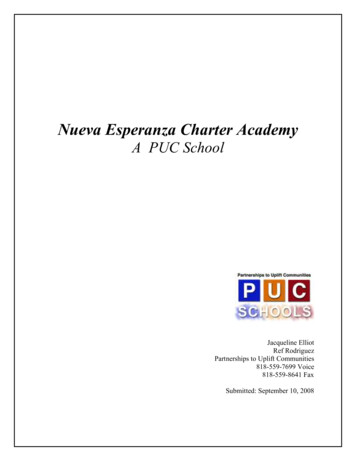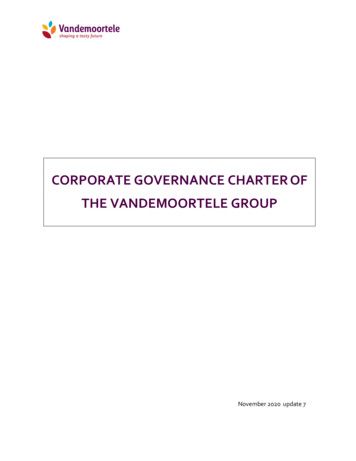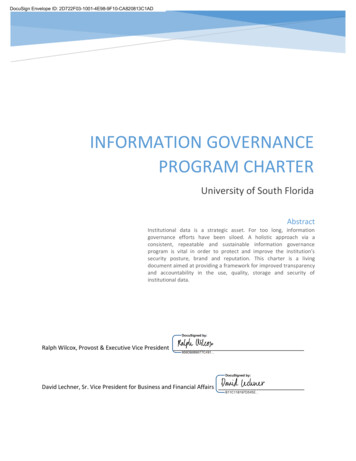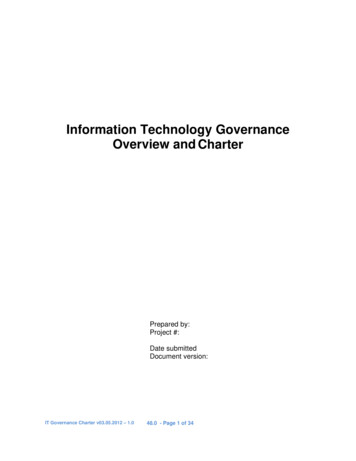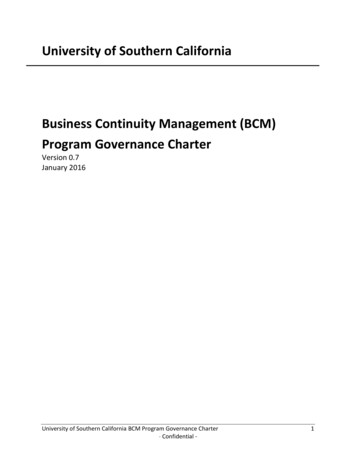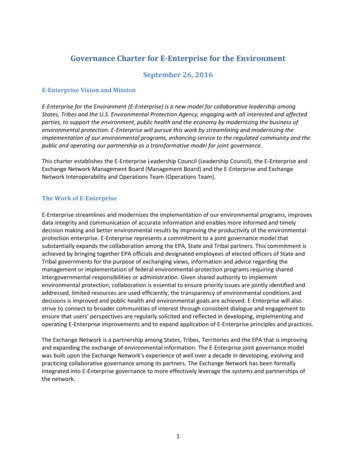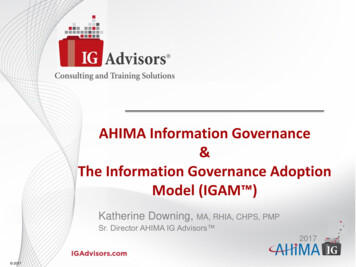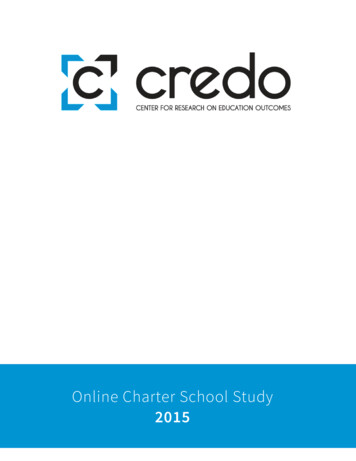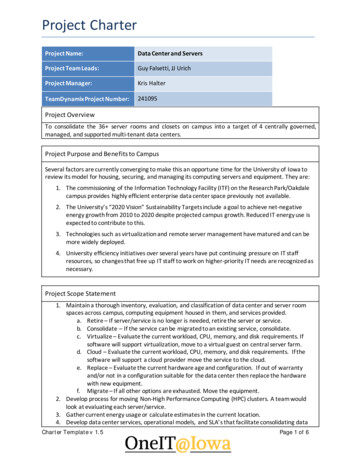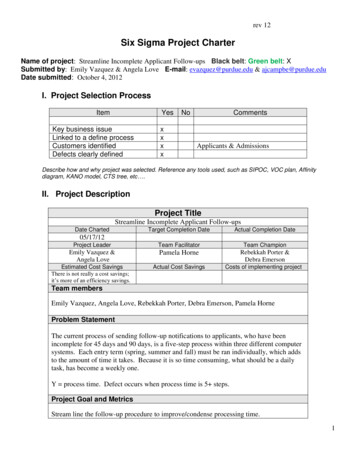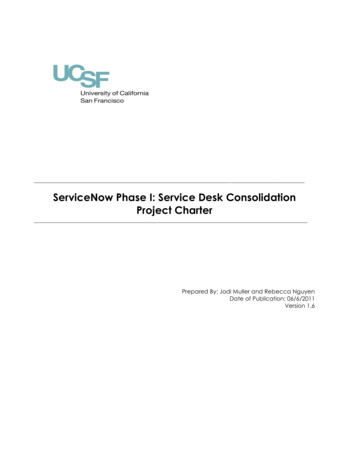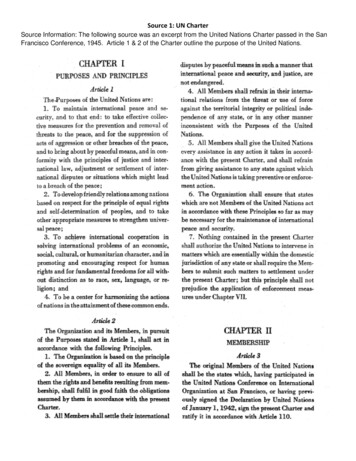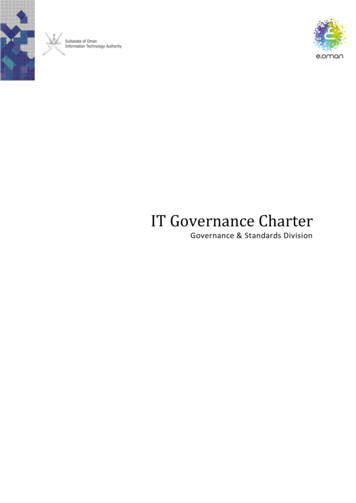
Transcription
IT Governance CharterGovernance & Standards Division
Table of Content1PURPOSE . 42INTRODUCTION . 43IMPLEMENTING IT GOVERNANCE POLICY . 63.1IT GOVERNANCE STRUCTURE - IT INVESTMENT COUNCIL . 63.2COUNCIL CHAIR . 63.3COUNCIL MEMBERSHIP . 63.4RESPONSIBILITIES . 73.4.1 Responsibilities of the IT Investment Council . 73.4.2 Responsibilities of the Director IT. 83.4.3 Responsibilities of the LOB Executives . 83.4.4 Responsibilities of Others (as Required) . 93.5EXCEPTION PROCESS . 93.6MEETINGS AND TYPES OF DECISIONS . 103.6.1 Three Key Meetings . 103.6.2 Additional Topic-Specific Meetings . 103.6.3 Ongoing Meetings . 103.6.4 Annual Meetings . 114IT MANAGEMENT PRIORITIES . 124.1ESTABLISH IT MANAGEMENT FRAMEWORK . 134.1.1 Roles and Responsibilities . 144.2FORMULATE IT STRATEGY . 154.2.1 Roles and Responsibilities . 154.3MANAGE ENTERPRISE ARCHITECTURE AND INNOVATION. 164.3.1 Roles and Responsibilities . 174.4MANAGE IT INVESTMENTS . 184.4.1 Roles and Responsibilities . 194.5MANAGE IT RISKS . 204.5.1 Roles and Responsibilities . 204.6MANAGE PROGRAM AND PROJECTS. 214.6.1 Roles and Responsibilities . 234.7MANAGE IT SERVICE DELIVERY . 234.7.1 Roles and Responsibilities . 244.8MANAGE INFORMATION SECURITY . 254.8.1 Roles and Responsibilities . 254.9MANAGE IT PERFORMANCE . 264.9.1 Roles and Responsibilities . 26Document Ref.N0ITA-IT Governance CharterRevision. No.1Revision.Date13/09/2018Page No2
Document Ref.N0ITA-IT Governance CharterRevision. No.1Revision.Date13/09/2018Page No3
1PURPOSEThe purpose of this IT Governance Charter is to provide implementation guidance for the ITGovernance Policy and related information technology (IT) management practices.IT Governance Policy is issued by Information Technology Authority (ITA) and outlines followingrequirements:a.b.c.d.IT Governance Goals and ObjectivesDirection for IT Investment ManagementPrinciples of IT Governance and ManagementPriorities for IT Governance and ManagementTo implement the requirements of IT Governance Policy, ITA is publishing this charter. This Charter isa result of extensive research on international standards and best practices and reflects inputs fromIT Governance communities and different governance models in public sector organizations.2INTRODUCTIONInformation Technology (IT) represents a significant investment as well as a significant enabler of theeOman vision, requiring effective governance and planning. Pursuant to, Royal Decree 52/2006,Information Technology Authority (ITA) is responsible for implementation of the Digital OmanStrategy and to provide professional leadership to government agencies.ITA act as a central IT governing body and coordinate IT planning efforts and strategies for mosteffective use of resources across the Government. ITA has exclusive responsibility to makerecommendations to the Cabinet of Ministers (Cabinet) on all information technology (IT) relatedmatters for the whole of government. Principal responsibilities include: Direct IT Governance strategies to government agencies, and advise technology prioritiesand major IT investments to the Cabinet of Ministers.Formulate and maintain policies for the governance and management of IT across thegovernment.Commission IT Governance framework for government agencies.Commission analyses and research pertaining to IT portfolio management.Ensure IT Assurance and compliance activitiesRecommend, to the Cabinet, strategic IT partnerships for the Government.To achieve the above objective, ITA has established an “IT Governance Framework” thatprovides architectural standards, policies, processes and guidance on the governance andmanagement of resources relating to the use of information & communication technologies(ICT).Document Ref.N0ITA-IT Governance CharterRevision. No.1Revision.Date13/09/2018Page No4
Figure 1: IT Governance FrameworkDocument Ref.N0ITA-IT Governance CharterRevision. No.1Revision.Date13/09/2018Page No5
3 IMPLEMENTING IT GOVERNANCE POLICYGovernance is about providing direction and ensuring that the results are being delivered. To setclear expectations with IT management and operations within government organizations, and toensure benefit realization and risk optimization in business investments in ICT initiatives, ITGovernance Policy defines the primary business goals for IT that each government agency shouldfocus on.Following sections provide explanation and guidance on implementation of policy requirements.3.1IT GOVERNANCE STRUCTURE - IT INVESTMENT COUNCILThe IT Investment Council (the Council) is responsible for the oversight and delivery of all investmentdecisions, including the overall strategic direction of the enterprise. The purpose of the ITInvestment Council is to ensure the effective and efficient use of technology in enabling theenterprise to achieve its strategy and goals within acceptable levels of risk. The IT InvestmentCouncil is tasked with and accountable for ensuring that technology services deliver business valueand that expected benefits from new investments are fully realized.This is a standing (permanent) governance structure. It may be supported by other governancestructures — both standing and project (temporary) — as required to effectively achieve its purpose.Decisions are made by discussing items or issues and coming to agreement. This agreement does notnecessarily mean that each member concurs with the decision itself, but rather, supports thedecision and will visibly demonstrate that support in the public arena within the company.Note: The existing structures (if any), like IT Steering Committee/eTransformationCommittee/Strategic Planning Committee, need to be enhanced or aligned with the proposed ITGS(IT Investment Council) to assume the accountabilities as defined below and to deliver the requiredresponsibilities.3.2COUNCIL CHAIRThe IT Investment Council will be chaired by the Undersecretary/CEO of the government agency. Thechair position will be a permanent position.3.3COUNCIL MEMBERSHIPThe IT Investment Council is composed of the top tier of leaders in the government organization:Document Ref.N0ITA-IT Governance CharterRevision. No.1Revision.Date13/09/2018Page No6
ctorLegal AffairsDG/GMAdminLine OfBusiness(LOB)ExecutivesNote: Line Of Business (LOB) Executives - these may be multiple roles representing Agencies’ corebusiness units, selected by the Council Chair.3.4RESPONSIBILITIES3.4.1 Responsibilities of the IT Investment CouncilThe IT Investment Council ensures that there is a business strategy for the enterprise and that ITinvestments are aligned to this business strategy within acceptable levels of risk (see the Meetingsand Types of Decisions section for more discussion about risk).Responsibilities include:Decide on strategy and capabilities. Determine the corporate strategy, objectives andcapabilities of the enterprise. Create a portfolio of assets and investments for theenterprise, and align technology services and investments with the corporate strategy andthe portfolio.Determine the investment approach. Create investment principles that serve to guideinvestment decisions for the enterprise. Determine the funding sources and financialauthority of the board, and establish audit responsibilities and accountabilities.Balance investment risk. Balance investment risk against potential investment opportunities,selecting those investments that are in line with the risk profile of the enterprise.Ensure a steady flow of communications. Communicate strategy and board investmentdecisions to stakeholders to create understanding at all levels of the enterprise about whichinvestments have been approved. Communicate changes to the business strategy that mayhave an impact on technology services and strategy.Document Ref.N0ITA-IT Governance CharterRevision. No.1Revision.Date13/09/2018Page No7
Deliver results. Ensure the progress of technology projects, services and investments at thestrategic level is successful. Resolve issues that impede the effective delivery ofinvestments. Ensure the enterprise and technology strategies are aligned and thatdeviations are consciously managed.Improve governance. Continuously assess the effectiveness of the governance process and ofthe IT Investment Council, and improve.Decide on quorum and decision making. Determine what represents sufficient meetingattendance and how decisions will be made. Recognize that if people do not attend themeetings, an issue exists. The governance chair then needs to talk to those individuals, andtry to re-engage them in the governance process. People tend not to abandon the process ifmeaningful decisions are to be made that effectively engage their expertise. Designgovernance meetings with this principle in mind.3.4.2 Responsibilities of the Director ITThe DIRECTOR IT ensures that the technology strategy is consistent with the business strategy andmeets the needs of other lines of business.Responsibilities include:Deliver a compelling vision of a future target state and the road map to get there inmanageable steps.Resolve cross-functional issues within the technology strategy.Implement the technology strategy.Ensure the enterprise architecture represents the business direction and strategy, as well asincorporates new and relevant technologies as appropriate to advance the mission of theorganization.3.4.3 Responsibilities of the LOB ExecutivesThe LOB executives work with the DIRECTOR IT to ensure that the business and technologystrategies are clearly understood and executed within their business areas. They are responsible forproviding regular reports to the IT Investment Council chair on the progress of business andtechnology investments and services at an operational level. All executives are accountable to the ITInvestment Council for successful delivery of their areas' business outcomes.Responsibilities include:Proactively and equally share in discussions to determine the enterprise strategy.Champion the enterprise and technology strategy within their respective lines of business.Ensure that LOB operational plans are consistent with the enterprise and technologystrategies.Document Ref.N0ITA-IT Governance CharterRevision. No.1Revision.Date13/09/2018Page No8
Ensure that existing and changing business needs are clearly understood by the IT InvestmentCouncil and are incorporated into the investment portfolio as appropriate.Leverage the architectural road map.Manage interdependencies with other business areas, partners and suppliers created by newinvestment and change projects. Influence and resolve cross-functional issues that resultfrom any new investment and change projects.Ensure that benefits from technology investments are completely realized.3.4.4 Responsibilities of Others (as Required)Other Council members include the DG/GM Finance, DG/Director legal affairs and DG/GM Admin.Their responsibilities are:Offer their unique perspective (legal, HR or finance) to the investment decision at hand.Provide specific industry insight as it relates to their respective areas — for example, upcominglegal changes, trends in labor markets, and customer changes and preferences — that mayinfluence the enterprise strategy.Participate as required to become an executive sponsor for initiatives, and ensure thoseinitiatives deliver the expected results.3.5EXCEPTION PROCESSThe IT Investment Council should incorporate an exception process into its governance process tocreate enterprise agility in the marketplace. Exceptions happen, and business changes. The purposeof this exception process is to accommodate these "out of cycle" changes to the business strategy,to capture consumer shifts, to adapt to regulatory change and/or to incorporate innovation into thebusiness model.To invoke the exception process, contact the IT Investment Council executive to whom you report,and be prepared to answer the following questions before being guided through the exceptionprocess:What is the opportunity that needs to be discussed?Why does this opportunity require out-of-cycle attention? For example, is this a competitiveopportunity that will help the enterprise advance in the marketplace?If agreed to by the IT Investment Council, where in the portfolio might the opportunity reside?For example, how will this change be accommodated?Document Ref.N0ITA-IT Governance CharterRevision. No.1Revision.Date13/09/2018Page No9
3.6MEETINGS AND TYPES OF DECISIONS3.6.1 Three Key MeetingsMeeting 1 — Approve the charter. Discuss the governance charter, and approve it. Create a"straw model" of the charter prior to the meeting, and review it with a few key stakeholders.Then, discuss and finalize the charter in the meeting itself.Meeting 2 — Establish prioritization criteria. Discuss and adopt the criteria used toprioritize investment initiatives. This activity is commonly led by the DG/GM Finance, but isdiscussed by the council since all investment initiatives will use this process. Straw-modelthe criteria first, and review it with a few key stakeholders. Then, discuss and finalize thecriteria in the meeting itself. In the meeting, review the current portfolio against theprioritization criteria, and adjust as required.Meeting 3 — Establish or review the enterprise strategy. Straw-model the strategy first,review the capabilities required to win in the marketplace and discuss the path forward.Adjust the current portfolio as required. 3.6.2 Additional Topic-Specific MeetingsDetermine the investment mix. Approximately 70 percent to "run the business." Is this mixof operating expenditure to capital expenditure appropriate, or does the enterprise neednew strategies to invest more in competitive change and advantage? What role doesstrategic value play in the investment?Review the supply pipe. How much demand that comes in should be accommodated?Decide on the sourcing strategy. How will demand be met? Should demand be met 100%using internal staff, or a combination of internal staff supplemented with externalpartnerships?Decide on investment hurdle rates or thresholds.Develop principles that will guide investment decisions, such as, "The enterprise willpurchase applications before developing new applications."Discuss other topics that may be identified by the council.3.6.3 Ongoing MeetingsOngoing meetings tend to fall into a rhythm. Determine the appropriate rhythm for this council bycreating a standard agenda. Ideas include: Review the status of major ongoing initiatives, and monitor steps and decisions made bysupporting steering committees.Review new demand against the prioritization criteria, the active portfolio and the ability tomeet demand (the supply pipe).Continue to monitor and study competitive shifts in the industry that might impact thebusiness strategy.Document Ref.N0ITA-IT Governance CharterRevision. No.1Revision.Date13/09/2018Page No10
3.6.4Annual MeetingsAssess the effectiveness of the council, based on the charter, and update the charter asrequired to improve performance for the next year.Assess the effectiveness of the governance process by comparing Council's effectivenessagainst their purpose and the relationship to one another.Review the Council charter, and answer the following questions: Is the Council effectively achieving its purpose and expected outcomes? Are the right stakeholders involved in the process? Is the exceptions process effectively capturing new opportunities for the enterprise?Document Ref.N0ITA-IT Governance CharterRevision. No.1Revision.Date13/09/2018Page No11
4IT MANAGEMENT PRIORITIESIT governance exists to inform and align decision making for information technology planning, policyand operations in order to meet business objectives, ascertain that risks are managed appropriatelyand verify that resources are being used responsibly and strategically.Because information technology services account for significant capital and operational expenses ingovernment agencies,
ITA-IT Governance Charter 1 13/09/2018 4 1 PURPOSE The purpose of this IT Governance Charter is to provide implementation guidance for the IT Governance Policy and related information technology (IT) management practices. IT Governance Policy is issued by Information Technology Authority (ITA) and outlines following requirements: a.
